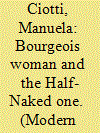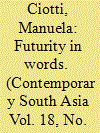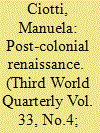|
|
|
Sort Order |
|
|
|
Items / Page
|
|
|
|
|
|
|
| Srl | Item |
| 1 |
ID:
078520


|
|
|
|
|
| Publication |
2006.
|
| Summary/Abstract |
This article draws on long-term ethnographic fieldwork in northern India on historically marginalised women's political participation. In particular, it examines women party activists in Dalit politics and the possibilities for the existence of feminist politics in the spaces analysed dense with masculine powers, caste identity-driven politicians and women's obstacles in building a political career for themselves. It is argued that these women present a theoretical impasse: labelling their practices as non-feminist would negatively connote the subjectivity and agency of those women who are engaged in different political worlds, even when they replicate dominant structures or embody traditions not exclusively based on the gendered individual as an actor or beneficiary of politics. Drawing from a comparison between women in Dalit politics and Hindu Right organisations, women activists are analysed through the lenses of their self-realisation trajectories, theirs and their political movements' relationship (or the absence of such a relationship) with gender progressive agendas, and the individual and collective consequences of their mobilisation. In doing so, this article aims to offer a portrait of women's political agency unconstrained by categories that, by themselves, might only offer partial explanations for everyday political life in a slum, a village or a state capital
|
|
|
|
|
|
|
|
|
|
|
|
|
|
|
|
| 2 |
ID:
096273


|
|
|
|
|
| Publication |
2010.
|
| Summary/Abstract |
This paper explores the interplay between development, identity politics and middle-class aspirations amongst low-caste Chamar women in rural north India. It argues that this interplay has reinvigorated notions of women's domesticity, education and modern conjugality as they emerged in the reforms and 'modernising' efforts of sections of Indian society, since the nineteenth century, in their encounter with the colonial 'civilising mission'. It will show how the long-term effects of this 'legacy', through its reconfiguration and appropriation by members from a low caste, have affected a historically marginalised community in their pursuit of middle-class aspirations. In addition to the criticality of Indian women and their gender roles as 'sites' where nation and community transformations are symbolically and practically negotiated, scholars of South Asia have also highlighted the separation between historical and anthropological discourses on women. This paper brings these discourses together and addresses this separation by showing that Chamar appropriation of the 'modernising' agenda has initiated a dual process. On the one hand, a minority of women have embarked on an embourgeoisement trajectory predicated on education, 'modern motherhood' and aspirations to white collar employment, and on the other hand, underprivileged women (with their 'unfit' personas) have become increasingly vulnerable to stigmatisation as a result of being in 'menial labour'. It is further argued that dialectic study of the 'two [groups of] Chamar women' will provide an insightful lens through which inner conflicts within low-caste communities in contemporary India may be understood, and suggests that there are contradictory trends concerning women, their development prospects, and their membership within the nation.
|
|
|
|
|
|
|
|
|
|
|
|
|
|
|
|
| 3 |
ID:
099926


|
|
|
|
|
| Publication |
2010.
|
| Summary/Abstract |
Drawing on ethnographic fieldwork in Uttar Pradesh, this article explores low-caste women political activists' self-representation. Low-caste communities have been mobilised to supra-local ideologies that posit 'classic' forms of subalternity such as the Dalit condition - and the rights and entitlements attached to it - as their rallying symbols. This article offers a counter-intuitive example to expressions of the burgeoning Dalit identity in north Indian society. In particular, it shows resistance to the usage of the Dalit label for self-representation by a number of low-caste women activists within the Bahujan Samaj Party. From women's narratives it emerges that 'Dalit' - implying a caste-laden ontological condition of subalternity - is denied on the grounds of its disempowering connotations. These narratives are all the more salient in consideration of the layered structure of gendered, socio-economic, cultural and political marginalities that low-caste women usually experience. While these findings unearth the discrepancies between subaltern pasts and cultures vis-a-vis their appropriation by low-caste women in contemporary north Indian society, they also point to vernacular understandings of 'Dalit' in circulation in the Uttar Pradesh public sphere. Moreover, these findings point to the need to de-link caste identity from agency, and to ethnography as a tool to (re)construct their nexus. Finally, by foregrounding the historicity of the Dalit label, this article encourages reflection on its widespread use.
|
|
|
|
|
|
|
|
|
|
|
|
|
|
|
|
| 4 |
ID:
113096


|
|
|
|
|
| Publication |
2012.
|
| Summary/Abstract |
Arjun Appadurai has argued that 'the materiality of objects in India is not yet completely penetrated by the logic of the market'.1
However, the entry and the visibility of modern and contemporary Indian art into the circuits of the global art world increasingly challenge this argument. The story of modern and contemporary Indian art is one of the inscription of local objects and their 'Indianness' into the above circuits, with market value being created inthe process. If the globalisation of the art world provides a conceptual and material arena where objects are circulated, displayed and bought and sold through auction houses, exhibitions, biennales and art fairs, this article analyses an event that epitomises some of the forces at play in this arena: the contemporary art exhibition 'The Empire Strikes Back: Indian Art Today' held in 2010 at the Saatchi Gallery, London. An artistic cum business instantiation of 'India in Europe'-and one that challenges the visual and aesthetic canons 'traditionally' associated with India-this article examines this exhibition as anentry point into the analysis of how neoliberal capital produces 'culture', and into the tension between the commodity form and the infinite possibilities, and unintended consequences, opened up by this very status.
|
|
|
|
|
|
|
|
|
|
|
|
|
|
|
|
|
|
|
|
|